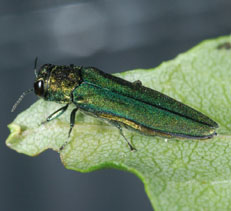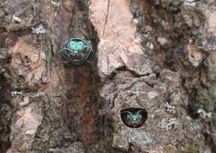The exotic emerald ash borer (EAB) has been killing ash trees across North America. Native to China, eastern Russia, Japan, and Korea, it was first discovered near Detroit in 2002 and has since spread to 25 states, including New Jersey.
Ash in New Jersey Facts
• Forests contain 24.7 million ash trees
• 24% of all forested land contains ash
• Ash is found in forests throughout the state, but concentrated in northern New Jersey
• Ash has been commonly planted as a street and landscape tree throughout the state
EAB: Deadly Damage to Millions of Trees
This metallic green insect infests and kills ash trees—all ash species are susceptible, with the exception of mountain ash. EAB larvae feed on the inner bark and disrupt the movement of water and nutrients, essentially girdling the tree. This insect often infests the upper branches of the tree first and may affect branches as small as 1” in diameter. It takes 2-4 years for infested trees to die, but mortality is imminent.
Since its discovery in North America, EAB has spread rapidly. It occurs in 25 states and 2 Canadian provinces. It was first discovered in NJ in 2014. The greatest impact will be for community trees and privately owned trees. The beetles are strong fliers, and good at finding ash trees. When the beetle first arrived in Maryland, the infested area expanded about ½ mile per year. Often people unintentionally spread this insect when they move firewood from an infested area to a new location. Beetles and larvae also hitchhike to a new area in nursery trees and saw logs.
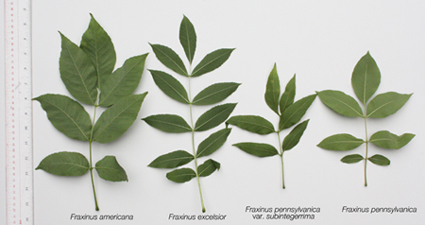
Is your tree an ash? Ash trees have compound leaves with five, seven, nine or 11 leaflets. See additional links at the end of this post to assist in determining if a tree is an ash, or contact your local Rutgers Cooperative Extension office. (Photo State of NJ Department of Agriculture)
What to Look for: Signs and Symptoms
Often the first sign that a tree is infested is woodpecker damage. When feeding on EAB, woodpeckers scrape off outer bark, leaving smooth, light colored patches.
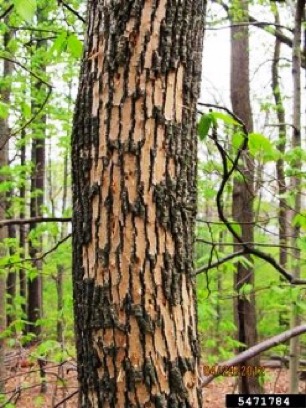
Several woodpecker species feed on EAB larvae. Heavy woodpecker damage on ash trees may be a sign of infestation. (Photo New Jersey EAB Task Force)
Under the bark of an infested tree, you can often see S-shaped galleries weaving back and forth on the surface of the wood.
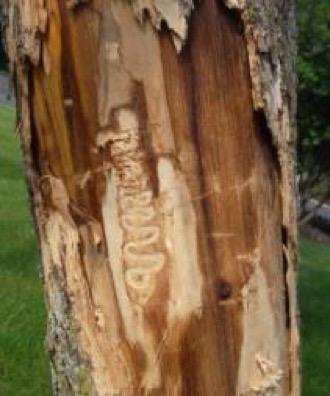
Feeding EAB larvae leave serpentine galleries across the woodgrain. (Photo New Jersey EAB Task Force)
The beetles also leave 1/8” D-shaped exit holes. Between May and August, you may find the ½” long metallic green adult beetles which have a copper color abdomen under the wing covers. For additional symptoms of EAB infestation, see Signs and Symptoms of the Emerald Ash Borer
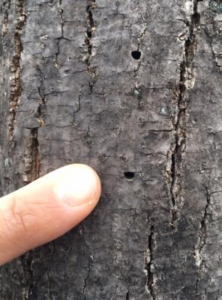
Adults leave D-shaped exit holes in the bark when they emerge in the spring. (Photo New Jersey EAB Task Force)
Managing Your Ash Trees
EAB is in New Jersey. Plan for EAB now if you have ash. Know what’s at risk: how much ash you have, its size and quality, and where it’s located. Consider the ecological, aesthetic, and economic value of your ash, your tolerance of risk, and your objectives for ownership. Use the assessment tool below to determine your best course of action:
Assess-ash-trees-chart
Forest Management
If your land is enrolled in Farmland Assessment or the Forest Stewardship Programs, you must follow your approved forest management plan or an approved amendment. Contact your consulting forester if you wish to change your planned activities, treatment schedule, or management objectives. Remember that the state forester needs to approve any changes before the management activity begins.
With an approved forest management plan that addresses EAB, you can salvage and restore ash in riparian areas when they follow the prescribed Best Management Practices. Reassess your plan if EAB is detected in or near your county. To date, EAB has been found in Somerset, Mercer and Burlington Counties. The threat of imminent tree mortality increases when EAB is within 10 miles of your property.
Take Action: What You Can Do
Identify ash trees. Ash species have opposite branches and leaves and a compound leaf with 5-11 leaflets. The bark has a unique diamond-shaped ridge bark on older trees, but younger trees may have smoother bark.
Monitor your ash trees for EAB, you will know when the risk of mortality becomes urgent. Look for the dying branches at the top of the tree, woodpecker damage, galleries under the bark, D-shaped holes, green adult beetle, and sprouting.
Spread the message, “Don’t Move Firewood.” Visitors who bring infested firewood to second homes or campgrounds near you put your trees at risk. Talk with neighbors and campground owners in your community.
Report EAB sightings to the NJ Department of Agriculture. Collect and/or photograph any suspect insects and larvae. Note that several insects look similar to the EAB.
Over the next few years, 99% of NJ ash trees will die due to emerald ash borer infestations
Where to Get More Information
NJ residents are encouraged to visit the New Jersey Emerald Ash Borer website: www.emeraldashborer.nj.gov where they can find resources on how to protect their ash trees and what to do with dead or dying trees.
Additional information on EAB:

